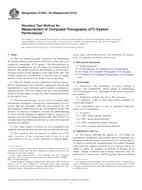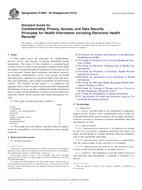Potrebujeme váš súhlas na využitie jednotlivých dát, aby sa vám okrem iného mohli ukazovať informácie týkajúce sa vašich záujmov. Súhlas udelíte kliknutím na tlačidlo „OK“.
ASTM E1672-12
Standard Guide for Computed Tomography (CT) System Selection
Automaticky preložený názov:
Štandardné príručka pre počítačovej tomografie (CT), systém výberu
NORMA vydaná dňa 15.6.2012
Informácie o norme:
Označenie normy: ASTM E1672-12
Poznámka: NEPLATNÁ
Dátum vydania normy: 15.6.2012
Kód tovaru: NS-42589
Počet strán: 12
Približná hmotnosť: 36 g (0.08 libier)
Krajina: Americká technická norma
Kategória: Technické normy ASTM
Kategórie - podobné normy:
Anotácia textu normy ASTM E1672-12 :
Keywords:
artifacts, computed tomography (CT), contrast discrimination, detectability, dynamic range imaging, non-destructive evaluation, spatial resolution, scan services, throughput, ICS Number Code 11.040.50 (Radiographic equipment)
Doplňujúce informácie
| Significance and Use | ||||||||||
|
This guide will aid the purchaser in generating a CT system specification. This guide covers the conversion of purchaser's requirements to system components that must occur for a useful CT system specification to be prepared. Additional information can be gained in discussions with potential suppliers or with independent consultants. This guide is applicable to purchasers seeking scan services. This guide is applicable to purchasers needing to procure a CT system for a specific examination application. |
||||||||||
| 1. Scope | ||||||||||
|
1.1 This guide covers guidelines for translating application requirements into computed tomography (CT) system requirements/specifications and establishes a common terminology to guide both purchaser and supplier in the CT system selection process. This guide is applicable to the purchaser of both CT systems and scan services. Computed tomography systems are complex instruments, consisting of many components that must correctly interact in order to yield images that repeatedly reproduce satisfactory examination results. Computed tomography system purchasers are generally concerned with application requirements. Computed tomography system suppliers are generally concerned with the system component selection to meet the purchaser's performance requirements. This guide is not intended to be limiting or restrictive, but rather to address the relationships between application requirements and performance specifications that must be understood and considered for proper CT system selection. 1.2 Computed tomography (CT) may be used for new applications or in place of radiography or radioscopy, provided that the capability to disclose physical features or indications that form the acceptance/rejection criteria is fully documented and available for review. In general, CT has lower spatial resolution than film radiography and is of comparable spatial resolution with digital radiography or radioscopy unless magnification is used. Magnification can be used in CT or radiography/radioscopy to increase spatial resolution but concurrently with loss of field of view. 1.3 Computed tomography (CT) systems use a set of transmission measurements made along a set of paths projected through the object from many different directions. Each of the transmission measurements within these views is digitized and stored in a computer, where they are subsequently conditioned (for example, normalized and corrected) and reconstructed, typically into slices of the object normal to the set of projection paths by one of a variety of techniques. If many slices are reconstructed, a three dimensional representation of the object is obtained. An in-depth treatment of CT principles is given in Guide E1441. 1.4 Computed tomography (CT), as with conventional radiography and radioscopic examinations, is broadly applicable to any material or object through which a beam of penetrating radiation may be passed and detected, including metals, plastics, ceramics, metallic/nonmetallic composite material and assemblies. The principal advantage of CT is that it has the potential to provide densitometric (that is, radiological density and geometry) images of thin cross sections through an object. In many newer systems the cross-sections are now combined into 3D data volumes for additional interpretation. Because of the absence of structural superposition, images may be much easier to interpret than conventional radiological images. The new purchaser can quickly learn to read CT data because images correspond more closely to the way the human mind visualizes 3D structures than conventional projection radiology. Further, because CT images are digital, the images may be enhanced, analyzed, compressed, archived, input as data into performance calculations, compared with digital data from other nondestructive evaluation modalities, or transmitted to other locations for remote viewing. 3D data sets can be rendered by computer graphics into solid models. The solid models can be sliced or segmented to reveal 3D internal information or output as CAD files. While many of the details are generic in nature, this guide implicitly assumes the use of penetrating radiation, specifically X rays and gamma rays. 1.5 Units—The values stated in SI units are to be regarded as standard. The values given in parentheses are mathematical conversions to inch-pound units that are provided for information only and are not considered standard. 1.6 This standard does not purport to address all of the safety concerns, if any, associated with its use. It is the responsibility of the user of this standard to establish appropriate safety and health practices and determine the applicability of regulatory limitations prior to use. |
||||||||||
| 2. Referenced Documents | ||||||||||
|
Podobné normy:
Historická
1.6.2013
Historická
1.3.2013
Historická
1.3.2010
Historická
1.3.2013
Historická
1.4.2014
Historická
1.6.2009
Odporúčame:
Aktualizácia technických noriem
Chcete mať istotu, že používate len platné technické normy?
Ponúkame Vám riešenie, ktoré Vám zaistí mesačný prehľad o aktuálnosti noriem, ktoré používate.
Chcete vedieť viac informácií ? Pozrite sa na túto stránku.



 ASTM E1695-95(2013)..
ASTM E1695-95(2013).. ASTM E1715-01(2013)..
ASTM E1715-01(2013).. ASTM E1744-04(2010)..
ASTM E1744-04(2010).. ASTM E1762-95(2013)..
ASTM E1762-95(2013).. ASTM E1869-04(2014)..
ASTM E1869-04(2014).. ASTM E1931-09
ASTM E1931-09
 Cookies
Cookies
